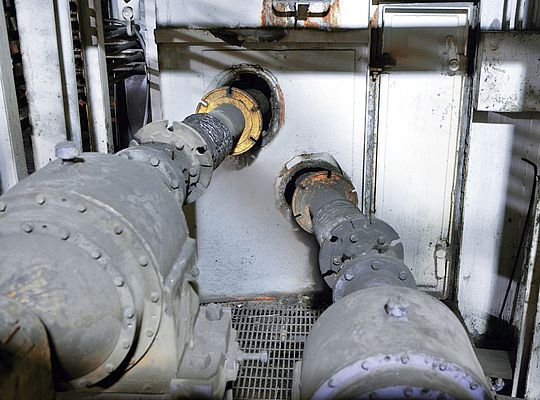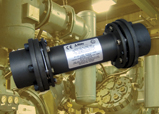At a major integrated steel works in the USA, U-joints are handling misalignment, shock loads, temperatures up to 1,500ºC and water spray, while improving the reliability of segment rolls on a continuous caster
The success of the universal joints (U-joints) in these arduous conditions is evidenced by the fact that, since installation, productivity has been improved substantially at the steelworks, and costly downtime - in what is a 24/7 continuous production environment - has been reduced.
The U-joints are employed to drive the segment rolls that form, move, and hold the steel slabs as they advance through the caster. The molten steel is poured from a ladle positioned about four stories above the mould. As the steel moves vertically between the rolls, the steel is formed into slabs that are 20 to 25cm thick and 1.2m inches wide. As the liquid steel is poured into a mould to form a slab, the U-joints are essential to controlling the motion of the slab and holding them in place. If one would slip, it would be devastating.
On the slab caster, a paired set of driven upper and lower segment rolls are housed in each segment frame. A total of 11 segments are positioned approximately 24 inches apart along the length of the curved roll section of the caster. The segments are equipped with a motor and gearbox drive train on alternating sides of the slab to allow closer, adjacent positioning. Due to the tight configuration of the dual drive trains, the U-joints are needed to compensate for an approximately 10-degree angular misalignment to connect to the drive end rollers positioned in the segments.
The joints are also required to function reliably in tough operating conditions that include: temperatures up to 1,500ºC, high-pressure water spray used to knock slag off the slabs forming as the steel cools, and high shock loads of up to 90,000nm torque. The slab caster operates continuously for 24 hours a day, from three to fourteen days, depending on steel production requirements.
The Problem
The U-joints used in this demanding application are Power Transmission Model U-3285 which feature a closed-yoke design, by Ameridrives, Bibby Transmissions’ sister company,. They were installed to replace units designed with split-flanged yokes. The problem with the split-yoke design was that the caps would either come loose from bolt fatigue or fail at the root of the yoke, causing the cross and bearing kit to eventually shear or snap under torque strains.
The U-joints also feature integral tapered face keys on both the motor and the drive ends. The motor ends of the U-joints are easily accessible, allowing maintenance crews to fully tighten the eight mounting bolts.
The driven (segment) ends of the U-joints, however, pass through the sidewall of the segment frame and are positioned within 30cm of a heat/water wall. The tight space constraints of the segment frame do not allow full access to the roller end of the U-joints. This resulted in mounting bolts that could not be tightened to the torque specifications.
Over time, the loose bolt connections between the spool and flange yoke (driven end) allowed the key to shift, causing the keyway and holes to become elongated in the mated flanges. This caused premature wear on the segment rollers, segment bearings, and flange yokes, resulting in uneven torque loads being transferred to other drives which over-torqued the next immediate segment, eventually causing the cross to fail within the flange yoke assembly.
When one segment roll is not driving, it can cause skidding, which creates uneven thickness and/or uneven marking on the slab, eventually causing problems in the slab finishing process. As a result of a cross failure, the slab caster needed to be shut down, allowed to cool (twelve or more hours). Then the damaged U-Joint would be repaired typically by replacing it with a spare. In some cases, slabs would have to be stopped, causing them to cool inside the caster, which required the trapped slab sections to be cut out and removed.
The Solution
Instead of the standard straight face key flange yokes, Ameridrives developed an integral tapered key or face pad design for the roller end of the U-joints in this application. The new face pad configuration featured four raised, wedge-shaped integral keys and required only four mounting bolts versus the typical eight-bolt design. The new U-joint face pad change also required the company to design and provide new roller spools with mating face pads. A pilot ring was also added to help center and stabilize the U-joint.
“The new design makes it easier to connect the U-joint to the segment roll spool, while allowing the torque to be transferred to the wedged cogs.” said Kurt Hansen, Ameridrives Couplings Steel Market Specialist. “Our extensive U-joint experience with steel mill applications allowed us to design a creative new facing connection that solved the customer’s dilemma. With the new reliability of the U-joint solution, the customer’s up-time is greater and slab quality has improved.
U-joints improve reliability
of continuous slab caster
- by Bibby Transmissions Ltd
- November 4, 2011
- 583 views




















